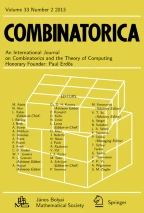501Accesses
46Citations
9Altmetric
1Mention
Abstract
Lett≥1 be an integer and letA be a family of subsets of {1,2,…,n} every two of which intersect in at leastt elements. Identifying the sets with their characteristic vectors in {0,1}n we study the maximal measure of such a family under a non uniform product measure. We prove, for a certain range of parameters, that thet-intersecting families of maximal measure are the families of all sets containingt fixed elements, and that the extremal examples are not only unique, but also stable: anyt-intersecting family that is close to attaining the maximal measure must in fact be close in structure to a genuine maximum family. This is stated precisely in Theorem 1.6.
We deduce some similar results for the more classical case of Erdős-Ko-Rado type theorems where all the sets in the family are restricted to be of a fixed size. See Corollary 1.7.
The main technique that we apply is spectral analysis of intersection matrices that encode the relevant combinatorial information concerning intersecting families. An interesting twist is that part of the linear algebra involved is done over certain polynomial rings and not in the traditional setting over the reals.
A crucial tool that we use is a recent result of Kindler and Safra [22] concerning Boolean functions whose Fourier transforms are concentrated on small sets.
This is a preview of subscription content,log in via an institution to check access.
Access this article
Subscribe and save
- Get 10 units per month
- Download Article/Chapter or eBook
- 1 Unit = 1 Article or 1 Chapter
- Cancel anytime
Buy Now
Price includes VAT (Japan)
Instant access to the full article PDF.
Similar content being viewed by others
References
R. Ahlswede andL. Khachatrian: The complete intersection theorem for systems of finite sets,European J. Combin.18(2) (1997), 125–136.
N. Alon,I. Dinur,E. Friedgut andB. Sudakov: Graph Products, Fourier Analysis and Spectral Techniques;G.A.F.A.14(5) (2004), 913–940.
N. Alon andJ. Spencer:The probabilistic method, Second edition, Wiley-Interscience Series in Discrete Mathematics and Optimization, Wiley-Interscience [John Wiley and Sons], New York, 2000.
J. Bourgain: On the distribution of the Fourier spectrum of boolean functions,Israel J. Math.131 (2002), 269–276.
P. Delsarte: The association schemes of coding theory, in:Combinatorics (Proc. NATO Advanced Study Inst., Breukelen, 1974), Part 1: Theory of designs, finite geometry and coding theory, pp. 139–157. Math. Centre Tracts, No. 55, Math.Centrum, Amsterdam, 1974.
I. Dinur andE. Friedgut: Intersecting families are approximately contained in juntas, in preparation.
I. Dinur andE. Friedgut: A proof of an intersection theorem via graph homomorphisms,Electron. J. Comb.13(1) (2006), #N6.
I. Dinur, E. Friegut andO. Regev: Independent sets in graph powers are almost contained in juntas, to appear inG.A.F.A.http://dx.doi.org/10.1007/s00039-008-0651-1
I. Dinur andS. Safra: On the importance of being biased (1.36 hardness of approximating Vertex-Cover),Annals of Mathematics, to appear.Proc. of 34th STOC, 2002.
P. Erdős,C. Ko andR. Rado: Intersection theorems for systems of finite sets,Quart. J. Math. Oxford, Ser. 212 (1961), 313–318.
P. C. Fishburn,P. Frankl,D. Freed,J. C. Lagarias andA. M. Odlyzko: Probabilities for intersecting systems and random subsets of finite sets,SIAM J. Algebraic Discrete Methods7(1) (1986), 73–79.
P. Frankl: The Erdős-Ko-Rado theorem is true for n = ckt, in:Combinatorics (Proc. Fifth Hungarian Colloq., Keszthely, 1976), Vol.I, pp. 365–375, Colloq. Math. Soc. János Bolyai, 18, North-Holland, Amsterdam-New York, 1978.
P. Frankl: On intersecting families of finite sets,J. Combin. Theory Ser. A24(2) (1978), 146–161.
P. Frankl andZ. Füredi: Beyond the Erdős-Ko-Rado theorem,J. Combin. Theory Ser. A56(2) (1991), 182–194.
P. Frankl andZ. Füredi: Finite projective spaces and intersecting hypergraphs,Combinatorica6(4) (1986), 335–354.
P. Frankl andN. Tokushige: Weighted multiply intersecting families,Studia Sci. Math. Hungar.40(3) (2003), 287–291.
E. Friedgut: A Katona-type proof of an Erd?os-Ko-Rado-type theorem,J. Combin. Theory Ser. A111(2) (2005), 239–244.
E. Friedgut,A. Naor andG. Kalai: Boolean Functions whose Fourier Transform is Concentrated on the First Two Levels,Adv. in Appl. Math.29 (2002), 427–437.
Z. Füredi: Erdős-Ko-Rado type theorems with upper bounds on the maximum degree, in:Algebraic methods in graph theory, Vol.I, II (Szeged, 1978), pp. 177–207, Colloq. Math. Soc. János Bolyai,25, North-Holland, Amsterdam-New York, 1981.
A. J. W. Hilton andE. C. Milner: Some intersection theorems for systems of finite sets,Quart. J. Math. Oxford,Ser. 218 (1967), 369–384.
A. J. Hoffman: On eigenvalues and colorings of graphs, in:1970 Graph Theory and its Applications (Proc. Advanced Sem., Math. Research Center, Univ. of Wisconsin, Madison, Wis., 1969), pp. 79–91, Academic Press, New York (Reviewer: R. C. Read).
G. Kindler andS. Safra: Noise-resistant boolean functions are juntas, submitted.
N. Linial,Y. Mansour andN. Nisan: Constant depth circuits, Fourier transform, and learnability;J. Assoc. Comput. Mach.40(3) (1993), 607–620.
L. Lovász: On the Shannon capacity of a graph,IEEE Transactions on Information Theory25 (1979), 1–7.
A. Schrijver: Association schemes and the Shannon capacity: Eberlein polynomials and the Erdős-Ko-Rado theorem; in:Algebraic methods in graph theory, Vol.I, II (Szeged, 1978), pp. 671–688, Colloq. Math. Soc. János Bolyai, 25, North-Holland, Amsterdam-New York, 1981.
R. M. Wilson: The exact bound in the Erdős-Ko-Rado theorem,Combinatorica4(2–3) (1984), 247–257.
Author information
Authors and Affiliations
Institute of Mathematics, Hebrew University, Jerusalem, Israel
Ehud Friedgut
- Ehud Friedgut
You can also search for this author inPubMed Google Scholar
Corresponding author
Correspondence toEhud Friedgut.
Additional information
Research supported in part by the Israel Science Foundation, grant no. 0329745.
Rights and permissions
About this article
Cite this article
Friedgut, E. On the measure of intersecting families, uniqueness and stability.Combinatorica28, 503–528 (2008). https://doi.org/10.1007/s00493-008-2318-9
Received:
Published:
Issue Date:
Share this article
Anyone you share the following link with will be able to read this content:
Sorry, a shareable link is not currently available for this article.
Provided by the Springer Nature SharedIt content-sharing initiative

